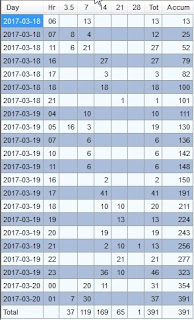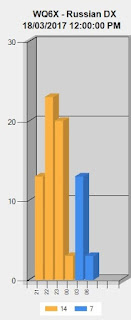In years past I have made the trek to NX6T (aka "NashVille") in Fallbrook in order that we could use the WQ6X call for WPX SSB & CW contests.
This year, because N6KI chose to join up with the NC6B conglomerate (in the SCV section) there did not seem to be any interest in putting together a multi-single or Multi-2 operation up on the mountain.
After a 5 second "arm twist" I agreed to run WQ6X solo. WQ6X is a sought-after prefix in the WPX contest, almost as "rare" as when I ran as WP2/WQ6X during our RTTY RU operation in 2014 (for which we received a 1st place Dx plaque). [CLICK Here] to read the write up about that and/or
go to the WP2/WQ6X webpage.
 |
| The WQ6X "Remote Desktop" |
My thinking was this would give me 18 hours to resolve the conflicts with the transmit audio flow in time for the 00:00z start time. Due to what became my "weird" audio-routing solution,
I ended up getting a late start (02:00z) with more problems surfacing a half hour into the operation.
One of the advantages in operating remote is that I can "take the contest with me",
whether at the office in between client sessions or flopped on the bed in front of the
TV, flipping thru cable channel drivel.
 |
| Towers #1 (Top) & #2 |
Doing this kept the amp heat and the shack
temperature down to 40-deg c) for safety reasons.
With the antennas being used and the advantage
of being located 900-ft above sea level, 800 watts
is more than adequate.
The "antenna farm" was the usual 13mh C-31XR tri-bander for the high bands, 2-elements on 40 and
an 80-m Inverted Vee broadside N/E - S/W.
Because operating 160 disrupts the internet connection, for obvious reasons I avoided top band for this WPX GiG. 160 only works @ NX6T when sitting in an actual operator chair.
This was an extremely frustrating weekend as I had everything going for me in this operation.
On the NashVille side I was blessed with Porque' Pig (guardian of the ACOM 2000 amplifier). Mr. Bill was also present - for good "Luck".
Additionally, there were EASY Buttons on BOTH sides of the internet connection for added assurance.
The computers and radios @ NX6T are protected by UPS facilities so I figured nothing could go wrong. However, because a remote operation is only as good as its most crucial microwave link, that must ALSO figure into the UPS recovery plan.
I guess they will add THAT feature NEXT week
@ the microwave site - OOOps.
 |
| Porque' Pig |
Once I learned how to direct DVK recordings to the K3's voice memory areas, after recording the usual CQ, callsign and TU messages I made sure to digitize the EASY Button for play back during times when I run a frequency. [CLICK Here] to hear the EASY Button.
Overall Saturday ran rather well altho throughout the weekend Auroral flutter made voices sound strange; sometimes resulting in 2 copies of the same signal coming at me simultaneously - very strange indeed.
I mostly ran frequencies interspersed with S&P thanks to spots on the band map. Even though there are no SSB skimmers, somehow WQ6X was manually spotted many times throughout the WPX contest. Having a 2x1 callsign makes being spotted more worthwhile.
40 meters brought a bunch of EU and even some AF QSOs - very nice for us Left Coast operators. Surprisingly,
80-meters yielded a dozen SA stations; not bad for an inverted Vee.
On Saturday 10 meters yielded only 2 QSOs (@23:00z) even tho I called CQ throughout the day.
Because propagation was so spotty and often localized, I made extensive use of the rotor controls
in this contest. While making use of the NX6T Stepp-IR's ability to run BI-directional or 180 at a moment's notice is a useful advantage, for remote setup I am relegated to running the antenna
as Antenna-B on the K3 radio; meaning a power level of 100 watts max.
Instead, I made judicious use of the remote rotor facility.
At times on 15 & 20 I would sweep the C-31 yagi from the North Pacific down to the South Pacific and back; amazed at the signals from "down under" which would quietly slip into the listen "window".
While signal levels were not great on the high bands, careful tuning and listening brought forth all kinds of "juicy" prefixes; which is what the WPX contest is all about.
The BiG disappointment came on Sunday (@19:20z) when a power failure occurred across the mountain at the internet microwave site with no human operators present to restore the power. I was in line to work TF3CW. For WQ6X, that power failure marked the end of the contest. The hoped-for 2nd shot at 15 & 10 meters never happened, and they were open and ready for alert Left Coasters.
An upside of this disappointment is that I learned how to program the K3's voice memories remotely, allowing me to run the contest largely with function keys.
I also made extensive use of the EASY Button ("That was Easy") when pressing F3 to send the "Thank You" message.
Because most "foreign" stations might not understand the significance of the EASY button, I tended to use it mainly for U.S. and Canadian contacts.
Did YOU hear the easy button?
[CLICK Here] to hear the Easy Button.
Minus the occasional random router spaz attacks, until the power failure, running NX6T remotely was almost like actually being there. Looking back, I was amazed that the internet connection was actually ready in time for contest start.
The router failure could have happened at anytime. I am thankful for having had nearly 43 hours of contest time available to me; how effectively I used those hours is shown in the statistics graph above.
Did YOU play in the WPX SSB contest?
Is WQ6X in YOUR Log?
WQ6X worked 273 unique prefixes for WPX SSB.
Is YOURS one of those 273?






























